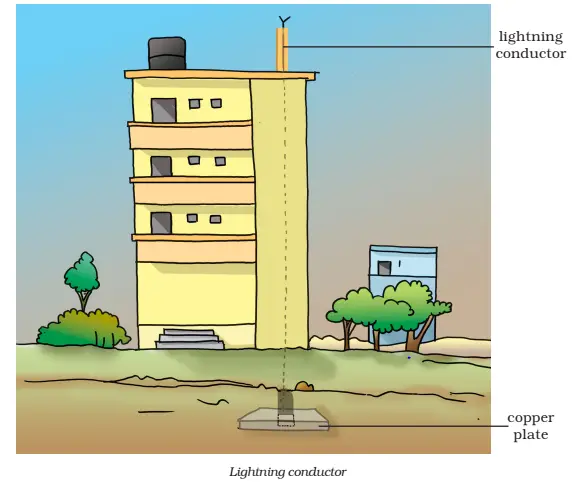

(i)Seismograph is an instrument used to measure the different magnitudes of earthquakes.
(ii)When the amount of charged particles in the clouds becomes very high then these charges tend to flow between the gap of air that produces a loud cracking sound called thunder.
(iii)The transfer of charges from one body to another due to physical contact is called conduction.
(iv)Friction is a process of transferring the charges from one body to another when they rubbed against each other.
(v)When the amount of charges increases in the clouds, these charges tend to flow in the air. This phenomenon is called electric discharge.
Ramesh needs to use an electroscope to detect the charge in an unknown body. An electroscope is a device that detects the charge in the body. It follows the principle of like charges repel each other.
The accumulation of charges produced by the electrical discharge from the clouds and air caused lightning.
The small plates of rocks present inside the upper region of the lithosphere are called tectonic plates. When these tectonic plates move and collide with each other, it causes the earthquake.
The following precautions that we can take during earthquake are: -
(i)Do not use the elevators.
(ii)Try to hide under the table.
(iii)One of the best possibilities occur during an earthquake is fire. Therefore, try to keep firefighting equipment with you.
Seismic waves are waves energy that travel through the earth’s layers. For example, the movement of tectonic plates, volcanic eruptions and explosions etc.
The following regions that can lead the earthquake are: -
Focus: It is region where the earthquake starts.
Epicentre: The place that is just above the focus is called epicentre. It is the maximum intensity region of the earthquake.
There are three main layers of the earth: -
Crust: The upper surface of the earth where we live.
Mantle: It is soft and dense part of the earth present just below the crust.
Core: The core is divided into two parts- inner core and outer core. The inner core is the solid part while the outer is the hot part where the metals are present in the molten state.
An electric eel produces up to 650 volts of electricity. It saves itself from the predators by electric discharge.
Working of the electroscope follows the steps that are given below: -
(i)First step starts with the identification of the charge. When a charged rod brought closer to the disc of the electroscope, the gold leaves acquire some charge that repel the charged rod because of the same charge acquaintance. However, when an uncharged body brought closer to the gold leaves, it shows no diversion.
(ii)Second step is to identify whether the body is a conductor or insulator. For this process, we need to connect two electroscopes (one charged body to the another uncharged body) with a copper wire. The observation divulges that the charge tends to flow from charged electroscope to the uncharged body electroscope through the copper wire. Thus, the gold leaves of previously uncharged body also diverge.
(iii)Third step to identify whether the body is negatively or positively charged. This method requires to connect the electroscope with a known charge. Now, bring the unknown body close to the disc of the electroscope. If the gold leaves diverge, the charges are same. On the contrary, if the divergence decreases, the charges are opposite.

Lightning conductor is a device used to protect the buildings from thunder and lightning. It is fixed at the top of the building and its lower end is attached to the ground by wires. During lightning, the charged clouds present over the building cause the induction between them and the top part of the lightning conductor. However, the lower part of clouds is negatively charged, they make the lightning conductor positively charged. The free electrons pass through the clouds to the lightning conductor then to the ground that protects the building from lightning.
The following precautions that we take during lightning and thunder are as follows: -
(i)Make sure you stay away from the tallest objects like poles and trees.
(ii)Unplug all electronic devices immediately as they tend to attract the lightning and thunder.
(iii)Stay away from the water bodies.
(iv)Use insulators, such as rubber and wood.
(v)Make sure the lightning conductor should be fixed on tall buildings.
This Some Natural Phenomena Class 8 Chapter 12 Extra Questions is prepared keeping in mind the latest syllabus of CBSE . This has been designed in a way to improve the academic performance of the students. If you find mistakes , please do provide the feedback on the mail.